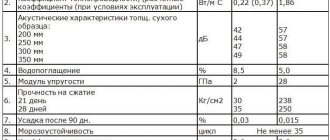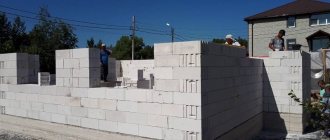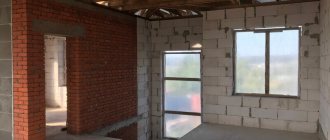Aerated concrete is a hardened building stone with evenly distributed spherical pores. Its properties, like other cellular concretes, are determined by the composition and structure, as well as the hardening conditions of the material.
GB structure
The difference between ordinary and cellular concrete is provided by pores: number, distribution, size, character. Aerated concrete has the following characteristics.
- The porosity of the material can reach 75–85%. GOST does not directly regulate porosity, but the number of pores determines the density of the material and its thermal insulation properties. The maximum number of pores will be in thermal insulating aerated concrete, since it is the air enclosed in the stone shell that guarantees thermal insulation. Structural aerated concrete with a density of 1200 kg/m3 will have the least porosity and the least insulation ability. m;
- The pores in aerated concrete are distributed evenly throughout the mass of the product. This is ensured by the production conditions: mixing the ingredients and conducting a chemical reaction directly in the concrete mass.
- The pore diameter ranges from 1 to 3 mm. Concrete with minimal pore size has the best performance. However, there is a nuance here: aerated concrete slurry is prone to delamination, and gas bubbles tend to rise during the reaction. As a result of the combined action of both factors, the pushing process has an upward direction. But the higher the gas bubble is, the larger the pore it forms. As a result, the pores are distributed evenly throughout the mass of aerated concrete, but in height they turn out to be different in size: the “upper” part of the mass is always lighter than the bottom.
- The pores in aerated concrete are open. This means that the material absorbs moisture indoors or from the street, and also evaporates it in both directions. Aerated concrete walls need protection.
Read on to learn more about the calculation and composition of the mixture per 1 m3 for monolithic aerated concrete and others produced with your own hands at home.
The following video talks about the proportions, composition and features of aerated concrete:
Advantages of aerated concrete blocks
Based on the above, we can highlight many advantages of aerated concrete blocks over other building materials:
- Aerated concrete blocks are 3-5 times lighter than ordinary bricks, which allows them to be produced in significant sizes. This in turn contributes to the high speed of construction of buildings. For example, one builder can build 1 sq. m. walls made of aerated concrete blocks in 20 minutes. In the case of brick, this figure is unattainable.
- Low thermal conductivity of aerated concrete, which is 2-3 times less than the thermal conductivity of brick. This is due to the presence of pores containing air. For example, with a block thickness of 37.5 cm, the thermal insulation is equal to 60 cm of brickwork.
- The ease of workability of aerated concrete blocks is comparable to wood. It is easy to saw, plane, and drill using ordinary carpenter's tools.
- High fire resistance of the material. Aerated concrete blocks are non-flammable. Moreover, they are able to withstand exposure to fire on one side for 3-7 hours.
- High vapor permeability of the material due to the presence of pores. As a result, the building “breathes”, providing an optimal microclimate inside.
- Highly environmentally friendly. According to the classification, the environmental friendliness of materials is determined by a special coefficient. For example, for brick it is 10, for expanded clay it is 20, and for aerated concrete it is 2. Only wood has a higher environmental friendliness (coefficient 1).
Composition and proportions of aerated concrete
According to GOST 25485-89, different types of aerated concrete are produced, which requires the use of different substances. In general, the starting mixture includes:
- silica component;
- astringent;
- water – unsalted and purified according to GOST 23732;
- aluminum powder - or paste in the form of a suspension;
- additional ingredients.
Solid components
Two main types of siliceous material are used as raw materials:
- quartz sand - the proportion of quartz is at least 90% or 75%, mica in the sand should be no more than 0.5%, clay impurities of various kinds - no more than 3%.;
- Fly ash is waste from thermal power plants. According to GOST, it contains no less than 45% silicon oxide and no less than 45% calcium oxide; no more than 3% of sulfur oxides are allowed.
Ore enrichment products are sometimes used as siliceous material if the quartz oxide content in it is not less than 60%.
The adjustable parameter is the specific surface area of the silica moiety. The value is selected according to the design density, thermal conductivity and other properties of the final product.
Binder
The following materials are used as binders:
- Portland cement - without trace, clay, flask, ash and other ingredients. It is also necessary that the proportion of calcium aluminate does not exceed 6%;
- quicklime – fast- and medium-slaking. Contains active calcium and magnesium oxides of at least 70%;
- blast furnace slag – granulated;
- highly basic ash – with a proportion of calcium oxide of at least 40% and with a proportion of sulfur oxide of no more than 3%.
Aerated concrete is further classified according to the type of binder, since their physical and chemical properties will differ.
Pore formers
To produce aerated concrete, aluminum powder of the PAP-1 and PAP-2 brands is used. Aluminum metal is explosive; it is added to the mixture while stirring in the form of a suspension with a ratio of aluminum to water of 1:10.
Aluminum paste can be used.
In the production of foam concrete, several different substances are used, but only aluminum powder will be the blowing agent for aerated concrete.
The following video talks about the effect of the hydrophobic composition of aerated concrete:
Additional Ingredients
The proportion of these substances in the mixture is very small. Their role is not the formation of a mass of the product, but the influence on the processes occurring in the substance during swelling and hardening. These can be structure formation regulators, plasticizing components, hardening catalysts, etc. The most commonly used include:
- gypsum stone;
- liquid sodium glass;
- technical caustic soda;
- soda ash – technical grade.
Due to its lower strength, various types of dispersed reinforcing fibers can be added to non-autoclaved aerated concrete. When swelling, the fiber is distributed throughout the mass of the product and placed in the interstitial partitions. In this way, a spatial mesh frame is formed, which increases the strength of the product.
Compound mixtures
In practice, the composition of the mixture is selected based on the requirements for the final product: strength, density, frost resistance, thermal conductivity, vapor permeability and other qualities regulated by GOST. Moreover, the standards indicate not only the expected strength classes and thermal insulation properties, but also the methods for evaluating the product.
Determine the appropriate composition through laboratory tests. To do this, a series of batches are carried out, where the ratio of binder and lime is changed. The volumetric weight and weight of the dried aerated concrete are controlled.
The main factor is the volume of blowing agent required to produce concrete with the required characteristics from a given ratio, since the blowing agent is the most expensive ingredient. The ratio of water and binder is selected so that the consistency remains cast at the lowest value.
Read below about the composition of aerated concrete and foam concrete.
For non-autoclave
In a non-autoclave composition, the components should not exceed the following standards: Portland cement - from 35.3 to 49.4, aluminum powder - from 0.06 to 0.1, lime - from 2.6 to 2.65, calcium chloride - from 0. 18 to 0.25, limestone - from 12.4 to 26.5 percent, and the rest is water.
Non-autoclave blocks are porous with gas. They are usually used in the construction of industrial, residential and administrative buildings for better thermal insulation. In some mixtures, caustic is introduced as an additive, and then the components of the mixture are taken in the following quantities: aluminum powder from 0.1 to 1, Portland cement from 15 to 50, caustic soda from 0.05 to 0.45, sand from 31 to 42 percent , and, of course, water. The nuance of the connection is a significant proportion of powder, as a result of which the price of aerated concrete increases.
Return to contents
Difference from the structure of foam concrete
Compound
Both materials are classified as cellular concrete, however, both the composition and the method of production are different.
- Concrete contains: quartz sand, cement - or other binder, water, additional ingredients and, of course, aluminum metal.
- Foam concrete contains: quartz sand, water, cement and ready-made technical foam based on bone glue, hide glue, caustic soda, pine rosin, and so on.
Physicochemical characteristics
The method of production differs even more strikingly: it no less affects the physicochemical properties of the product. Ingredients for aerated concrete are rushed into a high-speed mixer. They are added in the approved sequence, with the blowing agent entering the mixture last.
The pore formation or swelling reaction itself does not occur in the mixer, but later, when the concrete solution is in the molds. The hydrogen released during the chemical reaction permeates the entire mass of the mixture and forms evenly distributed pores of almost the same size.
This material reaches its undecked strength within a few hours. If autoclave processing is assumed, then the aerated concrete, after cutting into blocks, is transferred to an autoclave, where, under the influence of high pressure and humidity, a second series of reactions occurs, giving the product its design strength.
Non-autoclave hardens under natural conditions: its strength is always lower than that of autoclave.
Getting foam concrete looks completely different. Here, technical foam is formed separately and added after mixing cement, sand and water. Pores do not form in the material, but the porous material is mixed with the concrete. The uniformity of distribution directly depends on the thoroughness of mixing, however, it does not reach the same indicators as aerated concrete.
The pore sizes of foam concrete are larger, so the density is lower and the strength at the specified porosity is also lower - due to the diameter of the pores. But since ready-made foam and cement are mixed here, the number of open pores is lower than that of aerated concrete, so the former have better waterproof performance.
Foam concrete can be autoclaved, which also increases its strength.
Conclusion
Many experts prefer aerated concrete, because it has many advantages. Due to the fact that it is very light, you can build a building in the shortest possible time. It also does not require special equipment or continuous assistance. Aerated concrete is very durable, but at the same time it can be easily cut, sawed and drilled. This material is also frost-resistant, because with repeated freezing and thawing it loses no more than five percent of its strength.
It must be remembered that aerated concrete contains only natural ingredients. Due to their cellular structure, the blocks do not crumble, and their porosity allows you to maintain an ideal microclimate in the house.
Features of choosing a construction method
Methods for producing cellular concrete also determine possible construction methods.
- Prefabricated method - both aerated concrete and foam concrete are produced in the form of blocks. Moreover, for aerated concrete this is the only form of release. It can be a slab, a block, a complex element, but in any case it is manufactured not at the construction site, but at the production site. Both autoclave and non-autoclave methods involve casting a mass of aerated concrete and cutting it to size.
- for monolithic construction : technology simply does not allow it. Foam concrete can be obtained directly at the construction site and used for pouring monolithic walls or thermal insulation.
Aerated concrete is a material obtained not by mechanical mixing of ingredients, but by a chemical reaction between them. Its composition is selected in such a way that these reactions are carried out fully, the same applies to the selection of the composition of glue and plaster for aerated concrete.
What to choose for a private home
When choosing a gas block for your home, pay attention to the following factors:
- Weight. Large, high-density aerated blocks have a lot of weight. This means that the foundation will be subject to serious loads. Such features are taken into account when choosing materials and calculating the foundation for a house. Otherwise, the strength of the building remains in question. Laying the block on an unsuitable base will result in its destruction.
- Thermal insulation properties. If the material’s ability to prevent heat transfer is important, then you should choose gas silicate blocks. Aerated concrete is somewhat inferior, but has sufficient thermal insulation properties. Specifications decrease when the unit gets wet. Therefore, it is not recommended to postpone external wall decoration.
- Geometric accuracy. When laying with glue, it is recommended to use an autoclave block, which can be cut using special equipment. This allows you to obtain building stone with precise dimensions. If the masonry is carried out using a cement-sand mortar, then a non-autoclave block is also suitable.
- Price. The cost of an aerated block depends on several factors. The density, quality and dimensions of the block are taken into account. There is a relationship between price and quality. Cheap blocks have incorrect geometric dimensions or low strength.
All these factors are taken into account when designing a house. They make their choice responsibly. This will reduce costs and speed up construction.
For capital structures and interior partitions
Different blocks are used for structural elements. The choice largely depends on the properties of the material. If we talk about external main walls, then for their construction it is recommended to choose high-density aerated blocks. If there are fewer voids in the material, then its strength is higher, which is important for load-bearing structures. In this case, the number of storeys of the building is taken into account. It is not recommended to use aerated concrete for the construction of a cottage with more than 3 floors.
To raise load-bearing walls, use a gas block of a grade no lower than D600 and a thickness of at least 20 cm. This allows you to build a structure that will bear the load. The requirements for partitions inside the house are not so stringent. For their construction, a partition block 10 cm thick is sufficient. The use of such material will save internal space.
When constructing external walls, first pay attention to the density of the aerated block. Bearings must withstand the load from the structural elements of the building.
Lightweight clay cork concrete
Among organic fillers, in addition to straw and sawdust, cork chips are usually used. The advantages of this material include low bulk density. As for the disadvantages, this filler is quite expensive; in addition, the compressive strength of cork is significantly lower than expanded clay.
It must be stated that in construction stores you can find dry mixtures that contain the following components:
- Crushed clay;
- Cork chips;
- Straw fiber;
- Small amount of cellulose.
This mixture is much more often used as thermal insulation when constructing walls or plaster. Before use, the mixture is diluted in water.
The density of clay cork concrete is 300-450 kg per cubic meter. Thermal conductivity coefficient is 0.07-0.08 W/m K.
Overview of required equipment
Let's consider the features of aerated concrete production lines.
Conveyor
This type of equipment is different:
- the most automated process;
- minimal participation in the production of blocks by workers;
- significant cost;
- significant production volumes;
- all necessary completeness;
- high level of profitability.
The standard package includes:
- raw material containers and bunkers;
- belt-type conveyors through which components are supplied;
- unit for mixing the solution;
- autoclave units;
- forms;
- complex for cutting raw material into blocks;
- mixing conveyor;
- crushing plant;
- trolleys;
- remote control for controlling the process in automatic mode;
- forklift.
The price of such equipment is high, reaching 55,000,000 rubles. The amount is serious, but the productivity of the line makes it possible to produce at least three hundred thousand cubic meters of material in one year.
If you compare which manufacturer of gas blocks is better, then as an alternative it is recommended to pay attention to used equipment. There are certain risks, but the cost of the line will be significantly less
Continuing the comparison of gas blocks from different manufacturers, experts advise purchasing an Inntech-100 type conveyor. The cost is up to 3,000,000 rubles, and the productivity is much lower.
The peculiarity of such a line is the immobility of the mixing installation. Forms are moved and filled in automatically. The cutting complex is mechanical.
German block production lines are very popular. They are highly productive and are used for a long period. The material produced with such equipment is of high quality.
Stationary
Its cost is significantly lower than the first option. But in terms of productivity, the line will produce no more than fifty cubic meters of material per day.
The installation kit includes raw material dispensers and belt conveyors that supply components to the mixing unit.
Unfortunately, this kit is not considered fully automated. In order for it to function fully, you will have to attract several workers.
Mobile
This type of equipment is great for beginners who want to make blocks for their own use. By the way, some specialists make such equipment for aerated concrete with their own hands.
The line operates from a 220 W network, while other types of machines require 360 W. Production volumes are small - from two to ten cubic meters per day.
Frost resistance
When the temperature drops (for example, at night), the steam inside the walls condenses. In winter, it freezes and expands because ice exceeds water in volume. Naturally, this gradually but surely breaks down the walls. This process is characterized by frost resistance. It is determined by the number of freezing/thawing cycles after which the material is considered no longer suitable for performing its functions. Frost resistance is determined in the laboratory, freezing is carried out at minus 15-17 degrees Celsius, thawing at plus 20. A couple of freezing/thawing cycles in such conditions are equivalent to 3-5 years of exposure to the atmosphere. Aerated concrete has low frost resistance. F15 or F25, depending on whether concrete is used for internal partitions or external walls. For simple concrete, frost resistance is F50-F150. I gave the last value for clarity, so that I have something to compare with.
Specifications
Aerated concrete blocks are available in various sizes:
- 600x300x200;
- 600x300x300;
- 400x300x300;
- 600x400x300;
- 400x400x300.
As for the density parameters, it all depends on the specific brand of blocks:
- design options marked D1000-D1200 are distinguished by a density of 1000-1200 kg/1 m3;
- structural and thermal insulation parts of the D600-D900 brand are produced with a density of 500-900 kg/m3;
- thermal insulation materials of the D300-D500 brand have a density parameter from 300 to 500 kg/m3.
It should be noted that blocks of different densities can be distinguished by appearance.
Aerated concrete parts are manufactured with different strength classes. This indicator demonstrates how much load this material can withstand. So, for example, a block of strength class B2.5 can be used in the construction of strong load-bearing walls, the height of which can reach 20 m.
There are also materials that have the following classes, indicating their strength:
- V1.5;
- V2.0;
- B2.5;
- B3.5.
Aerated concrete blocks can have different thermal conductivity coefficients.
This indicator is designated as follows:
- 0,096;
- 0,12;
- 0,14;
- 0,17.
These parameters indicate the ability of a warmer space to transfer its heat to colder rooms. The higher the coefficient, the more noticeable the thermal output is. To determine the appropriate coefficient material for your home, you should consider the humidity level.
Another important parameter of aerated concrete blocks is their frost resistance. It is measured in cycles. For such building materials, designations from 25 to 100 are used. For comparison, you can take a brick, which can have no more than 50 frost resistance cycles.
As for the weight of m3 of aerated concrete blocks, it all depends on their direct marking:
- D300 – 300 kg;
- D400 – 400 kg;
- D500 – 500 kg;
- D600 – 600 kg;
- D700 – 700 kg;
- D800 – 800 g;
- D1000 – 1000 kg;
- D1100 – 1100 kg;
- D100 – 1200 kg.
Studying technology
Production begins with the preparatory stages:
- We assemble and install the mold, the inner walls of which must be treated with lubricant to avoid the mass sticking to the mold. The material from which the molds are made is wood or metal;
Plus - hardening occurs naturally
We prepare the main components for aerated concrete.
According to the proportions, we prepare the mass, pour it into the mold, and send it to the so-called maturation zone. First, the mass increases in volume. At this stage, aerated concrete becomes porous.
A chemical reaction occurs between aluminum powder and lime. The filling mass is evenly saturated with hydrogen bubbles, up to 2 mm in size; the cutting stage consists of sawing a large array (6160 mm x 1580 mm x 690 mm) into smaller parts. The top is removed and the surface is leveled with wire strings; we send the formed blocks for further drying and hardening in a natural way.











